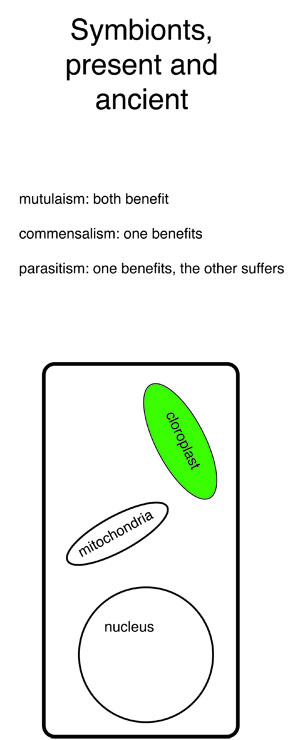May 2012: Symbionts on the Dock
All of the animals and plants on the Dock are influenced in some way by the other organisms on and near the Dock. In most cases the influence is very weak. In other cases the influence is intense but transient, e.g. one animal eats the other. In still other cases the relationship is longer term, but indirect, e.g. diatom colonies are part of the structure of amphipod burrows. However, the relationship between organisms can be direct and long term; in that case the two organisms are termed symbionts. In the right sidebar I have listed several categories of symbionts.
Marine symbionts
Ho et al. [1] describe a copepod that lives in the atrium of the ascidian Clavelina dellavallei. I have access only to the abstract of this article, and thus I don’t know anything about the functional relationship between these two species. I have often seen small ameoba-like organisms moving about on the inside of the atrium of Ciona, but I have no reference from the literature to link to this observation.
Donia et al. [2] describe the metabolic relationship and genomic sequences of the cyanobacterium Prochloron didemni, which is a symbiont of the ascidian Lissoclinum pattella [Lissoclinum patella - Encyclopedia of Life]. This association, which has been the subject of many studies, is dramatic and obvious because the cyanobacteria gives the ascidian a green color from the chlorophyll it produces. This association reminds us of the cyanobacteria that live in many of the reef corals, and play an essential role in their nutrition. Coral cyanobacteria have received a great deal of publicity in recent years because in some locations global warming has killed them, causing the coral polyps to become white and thus they appear to have been bleached.
The Donia paper also provides evidence of synthesis of several important sterols and lipids by the cyanobacteria. The same paper provides evidence that the ascidian harbors a variety of other bacterial species which could contribute other metabolites to the host ascidian. These results were only possible because the DNA sequences of the entire genomes of these organisms could be obtained without actual cultivation of the bacteria.
Human symbionts
Humans contain many symbionts. The first to be described were the ones you could see: the many worms and insects that cause discomfort and disease. After the invention of the microscope, which enabled microbes to be seen, and the development of the germ theory by Pasteur, many infectious diseases were linked to the bacteria which caused them. For many decades bacteria were considered to only be a potential danger to humans. A sterile environment was thought to be a healthy one. It is not so easy to learn about human symbionts. This is because most of what we knew until a few decades ago was motivated by medical needs. The book by Olsen [3] is a classic, but it is seems limited in todays times (2012).
Beneficial bacterial symbionts of humans were discovered as a result of the use of antibiotics. The use of some antibiotics kill sufficient intestinal bacteria to seriously impair ability to digest food. Healthy digestion could only be restored by administration of cultures of specific bacteria. We are now (2012) in the middle of an explosion of new information about symbionts associated with humans. This new information is due to the 10,000 fold decrease in cost of DNA sequence analysis in the last 8 years (since the nucleotide sequence of the human was first determined) [4]. It is now routine to collect “environmental” samples and sequence all DNA in the sample just to determine the organisms in that sample. We now know that there are characteristic groups of bacteria that are associated with healthy human skin, hair, intestine, genitals, etc. However, in most cases we don’t know the function these symbionts play (if any) in our health. To learn more about human symbionts, go to Wikipedia and look-up “microbiome” or " Human Microbiome Project".
Back to the Dock by way of the Reef
I have recently acquired the book Reef Life [5], which is at first glance a “coffee table book”; not that there is anything wrong with beautiful images. However, along with many stunning underwater photographs is a thoughtful and informative text. I mention the book here because an unusual number of symbionts are described. In addition, if you are interested in marine biology you should buy this book. I can't make a stronger recommendation.
Evolution of animal and plant cells
Finally, it is important to note that some of the organelles inside animal and plant cells are believed to have once been symbionts. Thus, the chloroplasts in eukaryotic plants cells originated from cyanobacteria, and the mitochondria in animal cells are believed to have been once just bacterial symbionts. The cell nucleus, a double walled organelle containing the DNA genome, which defines an eukaryotic cell, is also believed to be the remnant of a symbiont,
References
[1] A new family of cyclopoid copepods (Fratiidae) symbiotic in the ascidian (Clavelina dellavallei) from Cadiz, Spain. Ho, J., Conradi, M., Lopez-Gonzalez, P. Journal of Zoology, v 246, p 39 (1998)
[2] Complex microbiome underlying secondary and primary metabolism in the tunicate-Prochloron symbiosis. Donia, Mohamed S. et al., Proc Nat Acad Acad (US) v 51 p 108 (2011)
[3] Animal parasites. Their life cycles and ecology. O. Wilford Olsen, orig. pub. 1974, reprinted by Dover in 1986
[4] Integrating genomes (a review). Zerbino, DR et al. Science 336:179 (2012)
[5] Reef life. Natural history and behaviors of marine fishes and invertebrates. D. N. Tackett and L. Tackett. T. F. H. Publications 2002
